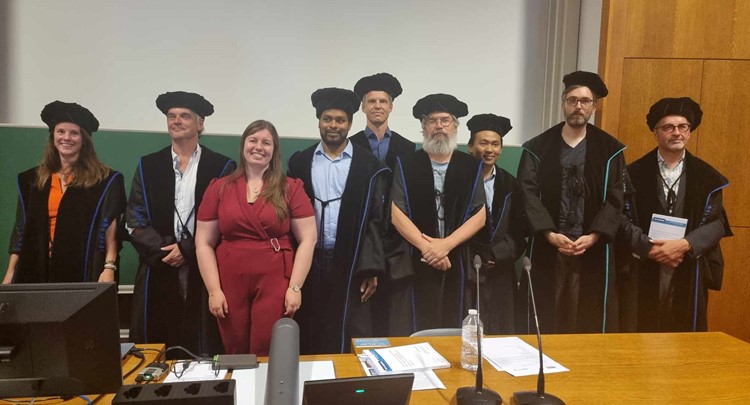Roeffaers Lab
Nanoscopy and catalysis
PhD Defence of Lotte Clinckemalie
PHD Defence Lotte Clinckemalie

On Wednesday 6th of September, in the aula of the Arenberg Castle, Lotte had her public PhD defence: "Development of High-Quality Perovskite Materials for Efficient and Stable Radiation Detection"
X-ray imaging is experiencing a significant growing demand in medical diagnostics, resulting in an expected market growth up to €3.8 Bn by 2027. However, the rise in X-ray imaging has led to more frequent exposure of harmful radiation to the human body, which in turn increases radiation-related health risks. To minimize the necessary X-ray exposure for obtaining an image, extensive research is being performed to develop more sensitive X-ray detectors. In the quest for more sensitive materials to reduce the operating radiation dose, metal halide perovskites (MHPs) hold significant potential due to their unique physicochemical properties. However, they still face significant challenges that hinder their commercial availability. One of the main obstacles is the long-term stability of the material. The most popular Pb-based MHPs can undergo phase transitions or complete degradation in response to environmental changes, resulting in a loss of the desirable optoelectronic properties. Another challenge is the deposition of large-area MHP layers for device applications, as conventional fabrication methods typically result in films with a high defect density. Finally, the eco-toxicity of lead-containing perovskites is cited as hampering their future implementation in realistic devices. A viable alternative to the lead halide perovskites are the so called double perovskites, as the corresponding single crystals have proven to generate sensitive and stable X-ray detectors. However, the synthesis of high-quality nano- or microcrystals need to be developed for their implementation in large-area devices. This PhD dissertation presents several promising pathways to address these challenges. Stable, phase-pure, highly crystalline lead-based and lead-free perovskites with excellent photonic properties have been successfully synthesized, characterized and investigated for their potential application as radiation detectors. In Chapter 1, an introduction on CsPbBr3 perovskite single crystals, microcrystals, nanowires, thin films, and nanocrystals was provided, highlighting the importance and challenges of diverse synthesis strategies of perovskite materials on the final performance as photo- and X-ray detectors. In Chapter 3, a new scalable fabrication method of compact, thick, and pinhole-free CsPbBr3 films was presented. Furthermore, we investigated how the implementation of the 2D CsPb2Br5 phase into CsPbBr3 microcrystals affects their structural and optical properties. It was found that the dual-phase sample demonstrates improved tolerance to higher voltage X-ray detection as it exhibits a much lower dark current, linked to suppressed ion migration. The demonstrated low dark current in combination with the plausible formation of shallow defect states, prevent the building up of polarization in the device configuration. This increased stability to higher voltage regimes provides a promising avenue for future improvements in fast, local charge extraction and X-ray image resolution. In Chapter 4, chemical vapor deposition was applied as an advanced synthesis strategy to fabricate smooth, high-quality and phase-pure CsPbBr3 thin films. The impact of the grain size on the carrier transport properties has also been examined, indicating an enhanced mobility upon increased grain size. Additionally, Rb-doping was performed as a strategy to boost the performance of the films as the photoactive layer in photodetectors. Finally, the insights gained from this research was utilized to optimize a home-built setup for the fabrication of CsPbBr3 thin films, with the aim of expanding this strategy towards other (lead-free) perovskite materials in the future. In Chapter 5, the potential application of lead-free perovskite Cs2AgBiBr6 microcrystals in the field of photodetection was highlighted. Cation exchange transformation was suggested as a synthesis method to fabricate microcrystals of higher quality compared to crystals fabricated by direct synthetic routes. To gain insights in the cation exchange process, the reaction mechanism from Cs3Bi2Br9 to Cs2AgBiBr6 has been studied to understand the crystal phase evolution as well as the changes in structural and optical properties of the materials at different stages of the reaction. Furthermore, a proof-of-concept photodetector device indicated that the Cs2AgBiBr6 microcrystals obtained by cation exchange exhibit an improved photoresponse when compared to those obtained by the direct antisolvent precipitation synthesis method. This crystallographic transformation may pave pathway for the development of difficult-to-access perovskite structures, which are not available via direct solution-based synthesis pathways. Overall, the findings presented in this PhD dissertation contribute to the advancement of Pb-based and lead-free MHP materials for radiation detection. Three promising synthesis methods were explored and optimized to address the challenges related to the material stability of MHPs, the development of large-area pinhole-free films for device fabrication, and the lead toxicity. This PhD dissertation provides valuable insights obtained via advanced structural and optical studies and indicates the potential of perovskites as low- and high-energy photodetectors in the future.
To enable comments sign up for a Disqus account and enter your Disqus shortname in the Articulate node settings.